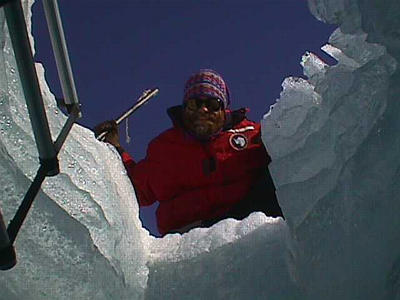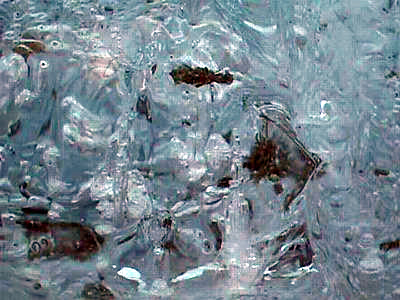15 November, 1998
Last night was another cold night, but this morning was sunny and warm.
I woke up at 7:45 and got going on my 12-hour time point in my
experiment at 8:00 am. It didn't take me as long this morning.
There was a point in the morning at which the temperature gauge on the
Jamesway read 55 degrees F...the gauge was in the sun, but even so,
that's pretty warm for Antarctica! I think it may even be a little
colder at home...
It is tradition that John makes crepes (cheese-filled and
fruit-filled...yum!) for everyone each Sunday morning, so while John was
making crepes, I checked my e-mail messages. The crepes were great!
I checked the preway heater fuel (to make sure that it wasn't going to
drain empty on us) and topped off the barrel. I gathered 3 loads of ice
berries for our drinking water (more this time because Ed was testing
out his sensors and needed a bucket of water to do so). The sensors that
he will be placing in the ice will be measuring the liquid water content
of the ice. Why is that important to us? Liquid water pockets are what
cause sediments to drift down through the ice. They are also important
for algal and bacteria photosynthesis. We should be able to relate what
he finds with what we find out about the algae and bacteria. There are
so many aspects that need to be looked at in an ecosystem. Everything
is tied together somehow.
I made 3 loaves of bread and started on an Excel spreadsheet, compiling
all of my data from my sediment transect samples on November 6 and 7.
My lab book is full of data (what????I am actually keeping a lab
book?...I thought that was only for torturing my biology students back
home!...No, actually "real" scientists must also keep lab books...how
can they remember all of the steps that they take and the data that they
collect?), and I want to make it easier for them to do some analysis on
the numbers that I have collected. Remember all of those scintillation
vials that I filled with sediment? That was what I was typing into a
spreadsheet.
As I was typing the spreadsheet, John came into the Jamesway and
announced that the pee barrel had overflowed and that we were going to
have to siphon off some of the urine and change the barrel. Yuck! Yes,
he did siphon off about 5 gallons of the urine (have you ever seen me
siphon off the saltwater aquarium in the room...sort of like that where
you suck on one end of a tube until you get enough water in the tube to
keep the flow going...except this time it was urine)...the frozen urine
had to be chipped off the top of the barrel, the barrel capped and
rolled down the hill to await flying back to McMurdo. It's much easier
to catch it BEFORE it overflows!
I made some sandwiches for lunch (with the baked bread), and then I
spent my afternoon helping Ed with digging out his icepit. Actually, I
just stayed on the surface and handed Ed what he needed in the pit. He
attached a rope ladder into the surface ice with ice screws so anyone
could easily climb in and out of the pit. He used the ice chipper bar
to chip away ice, collect the ice in a burlap bag, and hand it up to me
to dump out on the surface. The main reason he needed me was to "spot"
him while he used an electrical chainsaw down in the pit. There was
danger of getting caught in the electrical cord, of water and ice
building up on the blade, and of getting hurt and not having help. You
might be wondering where we get the electricity from. We use portable
generators on the ice. They are also used for the burners that are used
to melt the ice.
This took the majority of the afternoon. We returned to the Jamesway
around 7:00 pm. John made steaks with onions and garlic, baked
potatoes, and green beans. At 8:00 pm I did my 24 hour time points in
my experiment-- filtering off the 100 ml of meltwater from each of the
bottles of sediment (2cm, 300um, and 63um)-- and pouring that filtrate
into 3 more bottles (40 ml for nutrient analysis, 30 mls for cation
analysis, and 30 mls for anion analysis). Later these bottles will go
to the lab at ASA (Antarctic Support Associates) for analysis. They
will give us a spreadsheet of the results.
I did the dishes and caught up on my journal once more. I went to bed
at 10:30 pm (with my hot water bottle, of course).

I climbed down 3 meters into the ice pit to take some pictures of the sediment in the ice. This picture is of Ed peering down into the ice pit. The Water Content Reflectometer sensors will be placed into this pit. They will record the liquid content of the ice over time.

These are some of the bubble formations and sediment pockets I could see in the ice when I was in the 3 meter ice pit. Isn't the ice incredible?
Contact the TEA in the field at
.
If you cannot connect through your browser, copy the
TEA's e-mail address in the "To:" line of
your favorite e-mail package.
|
